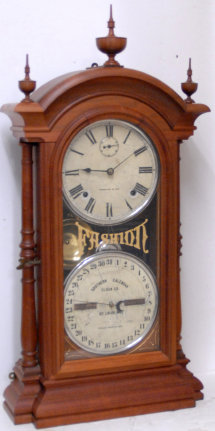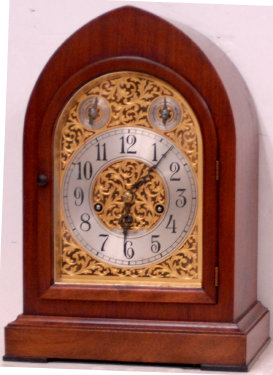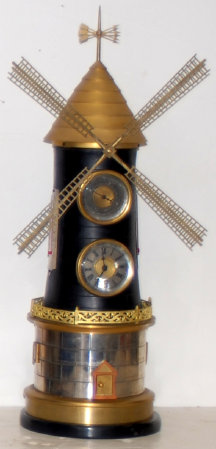

3. $300
Seth Thomas Clock Co. “Chime Clock No. 72”, ca 1921. It
has the No. 113, three-train movement chiming each quarter hour on tuned rods. The movement is signed, running, has the original
pendulum bob, and a key for winding. Mahogany cabinet case is 10” wide and 15” high. Case is excellent, like new and clean. Two tone mahogany contrasting panels on the front. The silver dial with black numerals is very nice for the type dial. Normally the silver dials would show considerable wear. The dial is signed, nice fancy hands are correct, flat glass,
and good fancy pierced dial surround that is hand cut and hand engraved, and is also signed. This clock is excellent. Ly-Seth
Thomas #406. $350-$500.

4. $550
Seth Thomas Clock Co. “Regulator No. 2”,
ca 1909. This 36” oak case has a slightly different oak grain appearance, I assume quarter sawn or something done differently. I am sure everyone is sick of me touting the Seth Thomas wall clocks, particularly the No. 2 Regulators, but it has to be the
most reliable clock ever made. It goes with any décor in any room of the house, office, or store. They are quiet, time
only, weight driven, and extremely well made and very reliable. The movements seldom need service unless you hang one in a cement
plant, gravel pit, or somewhere dusty or smoky. This case is medium oak, clean, with all original wood parts. The clock
is good looking but there are some skeletons. The painted dial is new and the minute hand is new. Inside the case are
slivers of a paper label, beat scale, original brass bob and wood stick, original weight, and all have been polished. The 8
day movement is signed, a strong runner and has not missed a beat here in my office. It is the exact type movement for this
model, but the movement has been moved slightly, for what reason I do not know. Ly-Seth Thomas, pages 276-277. $550-$750.
2. $1000
Southern Calendar Clock Co. Saint Louis, Mo. “Fashion No. 3”, ca 1879. The 32” walnut case has a good polished finish, not crazed, and has very good gold in the incised
designs around the dial boards. The Fashion glass has good paint, the hands are all original as are the dials, and it has the
correct “Star Pendulum” which makes it correct for the No. 3 Fashion. The original painted dials have age lines and some paint
loss. Inside is a large brass bell, correct labels, original movements, and nickel dial rings. Outside there is an original
key and all the wood parts are original and very nice. I do notice a nick on the top where it is not noticeable. The finials
are dark and appear to be as old as the case but I doubt that these finials came with the clock. Overall this is a very nice
and original Fashion No. 3. Ly-Calendar, pages 284-285. $1250-$1500.


6. $4000
American/English standing astronomical regulator, ca 1830’s
or 1840’s. The mahogany gothic styled case is 96 inches tall and has no major repairs or replaced parts. The gothic arch
top has the same style as glazed door. There are excellent carvings on the case sides and bonnet sides. The mahogany is
figured, very clean and polished. So sorry the picture at the top is not clearer as it is too tall for my shop. Enlarge
the picture and you will get more detail of the top. Because I have never owned an astronomical grandfather clock and being
an accumulator of unusual and nice clocks I want to keep this one but better thinkers say no. It has a large 8 day, time only,
weight driven movement, with maintaining power, large original pendulum bob and gold painted stick, and original hands. The
weight is different and one would think had an extension on the bottom. Maybe so, but I have seen identical brass weights on
other English clocks. The movement is a strong runner. Dial has good paint with slight fading after nearly 200 years. An identical clock sold at Schmitt’s auction in 2014 for over $8000. Their dial was signed, “John Stokell, New York”. They credited him as being the maker. Another clock with an identical dial and some other similar features was advertised
in Skinner’s auction, April 2017. They credited the maker as “John Moore & Sons, Clerkenwell, London with case by T. N.
Lowther, ca 1840”. I believe our clock was made in England or Scotland and perhaps retailed by an American dealer. $5000-$7500.
1. $400
Southern Calendar Clock Co. “Fashion No. 2”,
ca 1877. This model is walnut veneered, stands 31” high, and was the last Fashion model that was veneered. Others were
made of solid walnut. It was the first model with three finials, and almost impossible to find one with good original veneer. The majority of the veneer on this case is holding tight. There are some small chips on the top but overall one of the
best No. 2 cases I have seen. The finials are original but all three have broken tips. I sell replacements turned from
walnut about 30 years ago but you will have to stain them to match the case. Both dials are original and retaining most of the
paint. There are some small chips and some paint repairs. Good paper label inside, a correct pendulum bob, and a good
8 day brass movement made by Seth Thomas Clock Co. for Southern Calendar Clock Co. It is signed by ST, clean and is running and striking
a brass bell each hour. Ly-Calendar, page 283. $500-$75


7. $450
French Industrial Series type clock, copied from originals
made in the 1800’s. The French companies produced several different styles of the Windmill and they are still popular today. The windmill blades wind different from the clock movement. The movement that drives the windmill is inside the door at
the base. You open that door to wind the windmill blades. The case is metal, some parts silver plated, some brass, and
some painted brown. Like the French originals this one has a thermometer on each side and a barometer above the clock dial. It has an 8 day time only clock movement. It is 20 inches tall to the top of the weathervane. If you are like me
and drool over the French Industrial Series clocks but would never fork over the money for one, you will enjoy this windmill and its
very reasonable minimum price. $600-$750.
